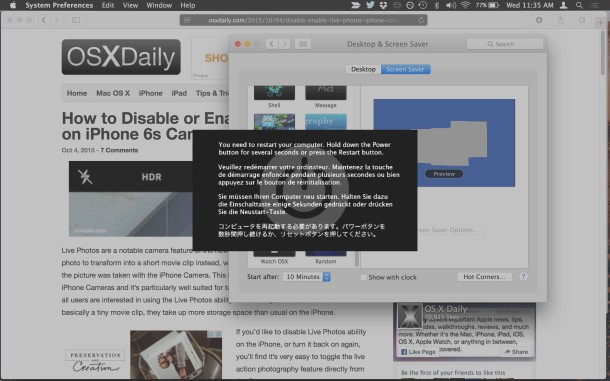Image For Screen Saver For Mac Os Sierra

You can create an empty disk image, add data to it, then use it to create disks, CDs, or DVDs. • In the Disk Utility app on your Mac, choose File > New Image > Blank Image. • Enter a filename for the disk image, add tags if necessary, then choose where to save it.
RedPill is a customizable Matrix screensaver for Mac OS X that was recently updated to support El Capitan, and Sierra. The Matrix caught the world by storm when it was released in 1999.
Mac Screen Saver
This is the name that appears in the Finder, where you save the disk image file before opening it. • In the Name field, enter the name for the disk image. This is the name that appears on your desktop and in the Finder sidebar, after you open the disk image. • In the Size field, enter a size for the disk image. • Click the Format pop-up menu, then choose the format for the disk: • If the disk image will be used with a Mac that has a solid state drive (SSD) and uses macOS 10.13 or later, choose APFS or APFS (Case-sensitive).
• If the disk image will be used with a Mac with macOS 10.12 or earlier, choose Mac OS Extended (Journaled) or Mac OS Extended (Case-sensitive, Journaled). • If the disk image will be used with a Mac or Windows computer and is 32 GB or less, choose MS-DOS (FAT); if it’s over 32 GB, choose ExFAT. • To encrypt the disk image, click the Encryption pop-up menu, then choose an encryption option. • Click the Partitions pop-up menu, then choose a partition layout. • Click the Image Format pop-up menu, then choose an option: • Sparse bundle disk image: Same as a sparse disk image (below), but the directory data for the image is stored differently. Uses the.sparsebundle file extension. Microsoft office for mac trial version download. • Sparse disk image: Creates an expandable file that shrinks and grows as needed.
No additional space is used. Uses the.sparseimage file extension. • Read/write disk image: Allows you to add files to the disk image after it’s created. Uses the.dmg file extension. • DVD/CD master: Changes the size of the image to 177 MB (CD 8 cm). Uses the.cdr file extension. • Click Save, then click Done.
Disk Utility creates the disk image file where you saved it in the Finder and mounts its disk icon on your desktop and in the Finder sidebar. • In the Finder, copy your files to the mounted disk image, then eject it. Convert any video for mac. For more information about disk image types, see the. You can create a disk image that includes the data and free space on a physical disk or connected device, such as a USB device. For example, if a USB device or volume is 80 GB with 10 GB of data, the disk image will be 80 GB in size and include data and free space.
You can then restore that disk image to another volume. • In the Disk Utility app on your Mac, select a disk, volume, or connected device in the sidebar. • Choose File > New Image, then choose “Image from [ device name].” • Enter a filename for the disk image, add tags if necessary, then choose where to save it. This is the name that appears in the Finder, where you save the disk image file before opening it.